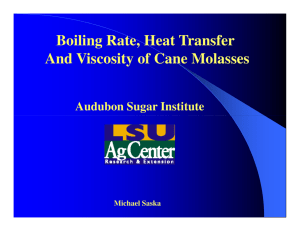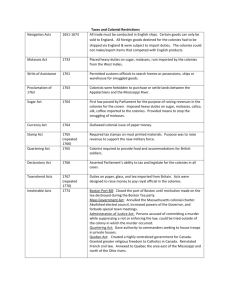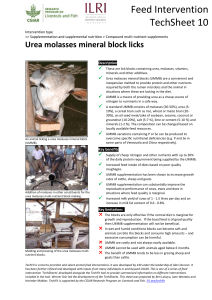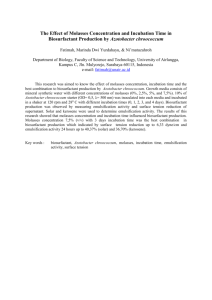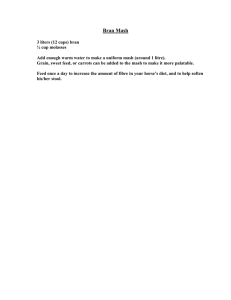Molasses in Feeds - Kentucky Equine Research
advertisement
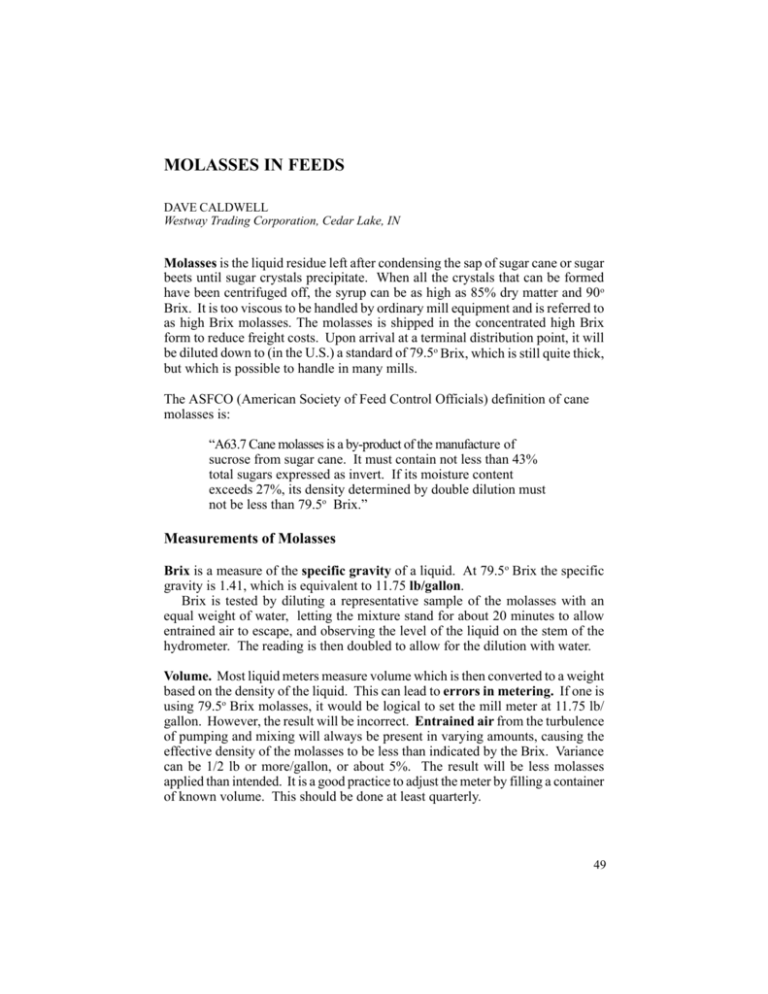
D. Caldwell 49 MOLASSES IN FEEDS DAVE CALDWELL Westway Trading Corporation, Cedar Lake, IN Molasses is the liquid residue left after condensing the sap of sugar cane or sugar beets until sugar crystals precipitate. When all the crystals that can be formed have been centrifuged off, the syrup can be as high as 85% dry matter and 90o Brix. It is too viscous to be handled by ordinary mill equipment and is referred to as high Brix molasses. The molasses is shipped in the concentrated high Brix form to reduce freight costs. Upon arrival at a terminal distribution point, it will be diluted down to (in the U.S.) a standard of 79.5o Brix, which is still quite thick, but which is possible to handle in many mills. The ASFCO (American Society of Feed Control Officials) definition of cane molasses is: “A63.7 Cane molasses is a by-product of the manufacture of sucrose from sugar cane. It must contain not less than 43% total sugars expressed as invert. If its moisture content exceeds 27%, its density determined by double dilution must not be less than 79.5o Brix.” Measurements of Molasses Brix is a measure of the specific gravity of a liquid. At 79.5o Brix the specific gravity is 1.41, which is equivalent to 11.75 lb/gallon. Brix is tested by diluting a representative sample of the molasses with an equal weight of water, letting the mixture stand for about 20 minutes to allow entrained air to escape, and observing the level of the liquid on the stem of the hydrometer. The reading is then doubled to allow for the dilution with water. Volume. Most liquid meters measure volume which is then converted to a weight based on the density of the liquid. This can lead to errors in metering. If one is using 79.5o Brix molasses, it would be logical to set the mill meter at 11.75 lb/ gallon. However, the result will be incorrect. Entrained air from the turbulence of pumping and mixing will always be present in varying amounts, causing the effective density of the molasses to be less than indicated by the Brix. Variance can be 1/2 lb or more/gallon, or about 5%. The result will be less molasses applied than intended. It is a good practice to adjust the meter by filling a container of known volume. This should be done at least quarterly. 49 50 Molasses in Feeds Temperature effects on molasses volume changes are not significant. Molasses does expand with increasing temperature, but the coefficient of expansion is small (about 0.0007 lb/gallon/oF), and is overwhelmed by the effect of entrained air. In fact, the increased viscosity of colder liquids will tend to hold more entrained air causing an increase in volume, the opposite effect of contraction due to the cold. Viscosity is the measure of resistance to flow. At room temperature, one extensive industry survey found molasses viscosities ranging from 1,100 - 7,150 cps (centipoids/second) depending on the source. Cane variety and processing can affect viscosity. Heating molasses reduces viscosity, which is why it may be desirable to have a preheat tank in a mill to help improve the mixability of the liquid product. As for the effect of cold, we in the molasses business could retire if we got a nickel every time we heard the term “as thick as molasses in January,” but it is true that very cold molasses can be so viscous that it can appear frozen. Viscosities can increase by 10 or more times with a 50 degree drop in temperature. Chemical Assay of Molasses Dry Matter — The most important chemical assay of molasses is its dry matter content. Obviously, nutrients can be found only in the dry matter fraction. Dry matter is measured by several means: Refractometer — Light passing through a liquid is bent, or refracted. The amount of refraction increases with density of the liquid. Increasing density is directly related to increasing dry matter content. The refractometer gives the least accurate of the estimates of dry matter in a liquid, but is the quickest and least affected by technique. Brix — Brix is a measure of density, and is therefore related to dry matter content. However, different solutes have different densities, so two liquids at the same Brix can have slightly different dry matter content. This method gives a slightly more accurate estimate of dry matter content than refraction, but is more easily affected by technique. Drying — This is the most common laboratory method of determining dry matter. It usually involves use of an oven, but some infrared heater/balance instruments are being used. This method will produce drastically incorrect results on molasses and other liquids if the oven or heater is set at too high a temperature. The oven should be at no more than 65oC because excessive temperature can drive off non-water components and can cause reactions that liberate compounds other than water. I have seen commercial D. Caldwell 51 laboratories report dry matters as much as 15% too low when excessive oven heat was used. Correctly done, this method is very accurate. Karl-Fischer — This method measures the reaction of the water in a liquid with a chemical mixture. The extent of the reaction is directly related to the moisture content. The instrument is much more expensive than that used in any other method, but it gives rapid results and is very accurate. Sugars — Total Sugars as Invert (TSAI) — Even though sugar is the primary material extracted from the condensed syrup, a great deal of unextractable sugar is still left in molasses. The sugar level remaining in molasses is generally expressed as TSAI. What does TSAI mean? Most naturally-occuring sugars exist as single sugar molecules (monosaccharides), or as disaccharides (two sugar molecules joined together). The ratio of monosaccharides and disaccharides in molasses and other liquids varies. In order to compare molasses with different proportions of monosaccharides and disaccharides, all the disaccharides are hydrolyzed to monosaccharides [by the addition of a molecule of water] is added to replace the bond between the two sugars. C12H22O11 + H2O ———— > C6H12O6 + C6H12O6 Atomic Weights 342 sugar+ 18 water 360 sugar The term “invert” refers to the fact that the plane of polarized light is rotated when passed through a disaccharide sugar solution. When the disaccharides are hydrolized to monosaccharides, the direction of rotation is reversed or “inverted,” thus the term Total Sugar as Invert. Several methods are used to measure sugar content. The most widely used is the Lane-Eynon, a volumetric/colorimetric method. Coming into more widespread use is individual sugar analysis by HPLC (high pressure liquid chromatography). Ash — The mineral matter in molasses can be measured by direct incineration. It commonly amounts to about 6-10% of the dry matter. Protein — There is a small amount of natural protein in cane molasses (about 3%) and a slightly larger amount in beet molasses (8%). In some cases, depending on origin and processing, cane molasses has contained as much as 10.6% protein. Protein content is projected from the nitrogen content obtained by the same wet chemistry means used for dry feedstuffs. NIR has not been used for liquid assay to my knowledge. 52 Molasses in Feeds Fiber — There is essentially no measureable fiber (crude, ADF, NDF) in molasses. Fat — Low levels of fat may be found in molasses, on the order of 1-2%. These assays are normally done by acid hydrolysis. Feed Energy — Some early digestion trials with high levels of molasses resulted in low digestibility values. This was due to the laxative effects of feeding impractical levels of molasses (more than 20%) and led to incorrect energy values for molasses which persist even today. More recent metabolism work in ruminants has shown that at normal inclusion rates (4-10%), the organic matter in molasses is almost completely utilized. This is in accordance with the fact that there is no structural fiber to impede microbial or enzymatic access to the organic compounds in the non-ash fraction. Thus, recent reviewers have found the energy content of molasses for ruminants to be 98% of the dry matter minus the ash content. Equine studies indicate that nonstructural carbohydrates are well utilized by the horse, but there is very little information on the energy value of molasses as such in the horse. Other nutrients — Wet chemistry methods are reliable for the macro- and microminerals. D. Caldwell Typical Composition The following is compiled from extensive corporate molasses databases. Typical Values for Cane Molasses at 79.5o Brix Nutrient Unit Dry Matter TSAI Protein Ash Est. TDN - Cattle % % % % % Calcium Chlorine Magnesium Phosphorus Potassium Sodium Sulfur Cobalt Copper Iodine Iron Manganese Zinc (As fed basis) Low High Average 67.5 44.9 1.2 5.9 58.2 74.6 50.2 10.6 13.4 66.0 71.5 47.2 3.5 8.5 62.9 % % % % % % % 0.02 0.33 0.12 0.05 1.24 0.05 0.34 0.84 2.27 0.58 0.48 2.64 0.48 1.31 0.57 1.19 0.33 0.10 3.98 0.21 0.86 ppm ppm ppm ppm ppm ppm 1.5 6.6 145 2.1 7.5 4.23 68.4 640 67.1 37.3 2.45 14.0 297 28.3 13.1 53 54 Molasses in Feeds Storing and Handling Liquids Most practical situations will have a mixture of best, intermediate, and worst conditions. The closer one can get to the “best” side of the chart, the better the results. Best Tank Orientation Tank Shape Tank Diameter Tank Material Tank Location Liquid Storage Time Min. Storage Temperature Max. Storage Temperature Agitation Pump Type Pump Location Pump Maintenance Meter Application Rate Control Lines Line Bends Line Shape Cleanout Vertical Cylinder w. cone <1/2 liquid depth Poly Inside, near mixer < 2 weeks Worst Cylinder Steel Horizontal Box >liquid depth Concrete Outside, distant > 3 months 55 o F > 10oF 80o F > 90o F Mechanical 2@ + gear Beside/Below Tank Monthly Checked Monthly Automated + Eyeball 2@ + Insulated 45o Elbows Straight Annual Recirculation Air Automated None 1” Centrifugal Beside Mixer Huh? Never Eyeball 1” Bare 90o Elbows Many bends Huh? A setup that sits mostly not on the “best” side of the chart can still function, but should be limited to simple liquid blends that are low viscosity at all temperatures. Operations on the “best” side will be able to use suspensions, high fat blends, etc. D. Caldwell 55 Liquid Blends Molasses is the primary liquid ingredient used in feed mill liquids, but there are many blends available. In fact, the majority of mills use blends instead of straight cane molasses. Other liquid ingredients that are available as part of mill blends are: Corn steepwater Condensed molasses solubles Soy solubles Distillers solubles Brewers solubles Lignin sulfonate Condensed whey Inclusion of these ingredients has become popular because the blends are lower viscosity and easier to handle. Generally, the blends are sold on the basis of dry matter content, ranging from 62% to 70%. They require less energy for mixing, and result in less buildup on equipment than straight cane molasses. Lignin sulfonate and whey are used in blends to aid pellet binding. Corn steepwater adds some natural protein to the mix. Brewers and distillers solubles and some of the condensed molasses solubles are derived from fermentation processes and are high in B-vitamins and amino acid precursors. Mold inhibitors can be included in the molasses blends, though they should be considered to be only part of the mold inhibition program. Flavors, vitamins, phosphorus and trace minerals can be added if desired. Fats are being added to some mill blends more for the effect they have on the appearance and handling characteristics of finished feed than for nutritional benefit. Texturized feeds retain a moist feel and appearance when treated with a molasses blend containing as little as 3% fat. Cold weather handling of texturized feed is dramatically improved by using a fat-containing blend. Fat-containing products are more demanding and are best used by mills with equipment fitting the left side of the Storing and Handling chart. 56 Molasses in Feeds Why Use Liquids Molasses and liquid blends: Improve palatability Reduce dust Reduce sorting Aid pelleting Help maintain moistness Help extend shelf life Improve mixing integrity Improve winter handling Carry additional nutrients References Official Publication - Association of American Feed Control Officials - 1997 The Analysis of Molasses - Pacific Molasses Company - 1986 Westway Trading Corporation - internal files - National Molasses Company survey Nutritional Requirements of Dairy Cattle - 1989. National Research Council, National Academy Press. Washington, D.C. Berger, L. - Determining the Energy Value of Liquid Feed Ingredients 1997 Liquid Feed Symposium - American Feed Industry Association Lofgreen, G.P and K.K. Otagaki, 1960, The net energy of blackstrap molasses for fattening steers as determined by a comparative slaughter technique. J. Anim. Sci. 19:392. Morrison, F.B., 1956, Feeds and Feeding (22nd. ed.) The Morrison Publishing Company Nofziger, J. - Determining the Nutritive Energy of Molasses -1995 Liquid Feed Symposium - American Feed Industry Association Scott, et. al. - Use of Chemical Composition or Near Infrared Reflectance Spectros copy to Predict the Gross Energy Content of Cane Molasses - 1990 Animal Sciences Research Report - Oklahoma State University - pp 147-153

